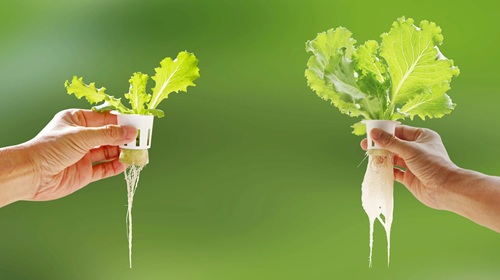Apr 25th 2025
5 Best Plants for Hydroponics: You Can Grow Plants Without Soil
At first, hydroponics may seem scary but the benefits are well worth the effort, and it's not as difficult as you would imagine. To put it simply, hydroponics is the process of growing plants without soil in a nutrient-rich water solution. And what do you know? This type of setting is ideal for many plants!
This blog post is for you if you're a novice gardener who is interested in hydroponics. We'll look at the best hydroponic plants, especially those that are easy for inexperienced gardeners to handle. Prepare to transform your house into a gorgeous, all-year flower sanctuary!
5 Plants You Can Grow in a Hydroponic System
Lettuce
When you ask yourself, "What is the fastest hydroponic crop?" you'll find that lettuce is a strong candidate. With a pH balance of 6.0 to 7.0, this low-maintenance, quick-growing vegetable prefers chilly temperatures. It will flourish in hydroponic tower system or an NFT setup (Nutrient Film Technique).
Due to its ease of cultivation, lettuce is the epitome of hydroponic farming. Romaine lettuce with its crispy texture is a great lettuce variety for hydroponics. If you’re looking for something with a softer texture give Buttercrunch a try, but any kind of salad green including baby lettuce that matures quickly can be used.

We advise trimming the outer leaves of your hydroponic lettuce while keeping the inner leaves whole so that they may continue to develop if you want to be able to pick it every day. This is called the “cut-and-come-again” method of harvesting. To guarantee that you always have a steady supply of fresh salad leaves, you may also space out when you plant your lettuce. Its growth cycle is brief; it is usually ready for harvesting in 30 days. Because it needs a lot of water and a well-regulated atmosphere, lettuce grows well in a hydroponic system.
Spinach
Compared to other hydroponically produced vegetables, spinach is easier to grow and cultivate. A few conditions are required in order to cultivate healthy hydroponic spinach plants. Systems that provide consistent and level nutrient delivery are ideal for spinach growth. For growing spinach, a Deep-Water Culture (DWC) or Nutrient Film Technique (NFT) technique is frequently advised in addition to hydroponic towers. Excellent oxygenation and nutrition supply are made possible by these systems, which are essential for spinach's quick and robust development.
In terms of light, spinach responds best to a 12-hour on / 12-hour off cycle. Direct sunshine is ideal although fluorescent, high-pressure sodium, or LED illumination are also suitable. It takes around 40-50 days from seed to harvest. Hydroponic spinach in fast-growing systems can be harvested in as little as 35 days.
Herbs
There are many different types of herbs that are ideal for hydroponic crops. According to studies, herbs cultivated hydroponically have a higher level of flavor and scent than those grown in the wild. Which plant are you hoping to cultivate? Well because of their compact root structure and low fertilizer requirements, herbs like basil, parsley, rosemary, thyme, oregano, mint, cilantro, chives and dill grow well in hydroponic systems.
Almost any system design may be used for a round of herbs while you get your bearings. Growing herbs is a fantastic opportunity to try out any new hydroponic system. These herbs will make it easier to enrich your home-cooked meals with new flavor.
Strawberries
Growing strawberries hydroponically has a number of benefits, such as year-round cultivation, increased yields in a smaller area, less exposure to pests and diseases carried by the soil, exact control over nutrient supply, and the possibility of quicker development and fruit production. Whichever hydroponic system you use, make sure the system oxygenates the roots well – this is the key to success when growing strawberries hydroponically. For this reason, aeroponic systems do particularly well.

For strawberries to thrive in hydroponic systems, they require a plenty of light. For the greatest outcomes, offer a steady 14 to 16 hours of light each day. Full-spectrum LED lights encourage robust growth and fruit development by simulating natural sunshine. Strawberries prefer colder temperatures, ideally between 50 to 55 degrees Fahrenheit at night and 65 to 75 degrees during the day. Maintaining a humidity level above 60% will aid in the plants' optimal absorption of calcium.
Tomatoes
Compared to conventional tomatoes, hydroponic tomatoes grow more quickly and produce more per square foot. This is because hydroponic setups provide an ideal and consistent supply of water and nutrients, removing plant stress and increasing photosynthetic efficiency. Because it can sustain root structure and offer sufficient support, substrate culture is frequently regarded as the best option for tomatoes. Although they are quite prolific, they need to have their pH balance and nutrition levels closely monitored.
Temperatures between 68°F and 77°F during the day and 64°F to 68°F at night are ideal for tomatoes. The secret to preventing heat stress is to keep the temperature steady. To encourage healthy development, relative humidity should be kept between 60% and 70% during the day and about 80% at night. A considerable amount of light is necessary for tomatoes. It is strongly advised to use appropriate LED light bulbs for plant development in indoor systems.
Final Thoughts
Hydroponics is a creative and sustainable agricultural method that offers a number of benefits over traditional soil-based methods. By picking the correct crops, optimizing the environment, managing pH and using cutting-edge products like A & B Nutrients for Hydroponics, you may increase yields and have a bountiful hydroponic harvest. Selecting a good hydroponic system, understanding the challenges, and following expert guidance will help you succeed in this rapidly growing space. Embrace the farming of the future with hydroponics and watch your crops flourish.




